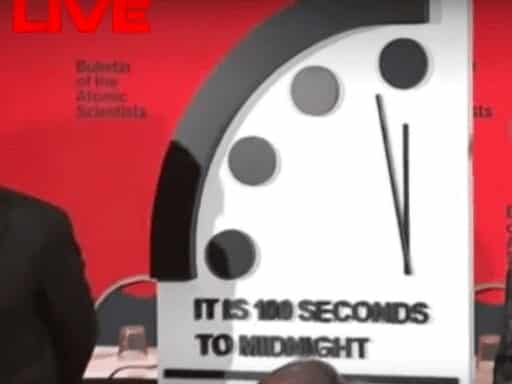Climate change, nuclear war, accelerating technology, and incompetent leadership threaten us.
The Bulletin of the Atomic Scientists was founded in 1945 by researchers who worked on the atomic bomb. It publishes research on “manmade existential threats such as nuclear war, climate change, and disruptive technologies.”
And lately, it’s been a little bit, well, doomsaying. Its famous extinction clock has hovered for the last few years at “two minutes to midnight” — as pessimistic a future as it predicted in 1953 during the volatile early Cold War.
On Thursday, the group moved the clock again, announcing that we are “100 seconds to midnight.” The change from minutes to seconds is a bit awkward, but it solves an important problem for the Bulletin of the Atomic Scientists: while the world does seem to be getting more dangerous, the danger mostly isn’t imminent (global civilization is overwhelmingly likely to survive the year 2020), and the Bulletin likely wants the ability to have some granularity in its risk assessments from one year to the next year.
The overall assessment that accompanied the 100-second clock unveiling is a gloomy one. All of the problems we faced last year are still facing us, and we have less time than ever to solve them. Both nuclear war and catastrophic effects from climate change, the Bulletin argues, grew more dangerous in 2019 — and world leaders made things worse.
“This situation — two major threats to human civilization, amplified by sophisticated, technology-propelled propaganda — would be serious enough if leaders around the world were focused on managing the danger and reducing the risk of catastrophe,” the Bulletin statement read. “Instead, over the last two years, we have seen influential leaders denigrate and discard the most effective methods for addressing complex threats — international agreements with strong verification regimes — in favor of their own narrow interests and domestic political gain.”
The result, the group argues, is that we’re closer to doomsday than we’ve ever been.
To claim that things are worse than they were during the Cold War — when, on occasion, we avoided nuclear armageddon only through the good instincts of a random person in the right place at the right time — is a very strong claim. The Bulletin announcement addresses this criticism head-on.
“To say the world is nearer to doomsday today than during the Cold War — when the United States and the Soviet Union had tens of thousands more nuclear weapons than they now possess — is to make a profound assertion that demands serious explanation,” the statement reads. But it argues it’s warranted because the old risks remain present while new risks including artificial intelligence and bioterrorism have joined them, and our international institutions are crumbling in the face of the challenge.
And while the Bulletin of the Atomic Scientists emphasizes, as it did last year, that the clock can move backward as well as forward, and that humanity’s future remains in our hands right up until midnight strikes, the overall tone of the message is distinctly pessimistic.
What the Doomsday Clock can tell us and what it can’t
In many ways, that pessimism is warranted. Humanity is now extremely unlikely to keep warming to the long-targeted 1.5 degrees Celsius, a target that would stave off many of the most severe effects of a changing climate. Iran is probably going to develop nuclear weapons to defend itself in the face of renewed US hostility. Populist authoritarians are likely to be in charge — at least a little while longer — in many countries whose investment in global institutions and international cooperation is badly needed.
But on the whole, I’m not persuaded that a second hand inching closer to doom is the right way to think about the challenges ahead of us — climate change especially. Climate change is bad, and it is killing people and animals right now. Over time, it will get worse and kill more people and animals. It is profoundly unlikely that it will wipe humanity out. It’s not some cathartic, cleansing doomsday we’re racing toward, just a worse world where more people suffer. And as my colleague David Roberts argued:
Framing the choice as “a miracle or extinction” just sets everyone up for massive disappointment, since neither is likely to unfold any time soon.
As climate scientist Kate Marvel put it, “Climate change isn’t a cliff we fall off, but a slope we slide down.” Every bit makes it worse. No matter how far down the slope we go, there’s never reason to give up fighting.
We’ve heard about the importance of optimism for combating climate change, and about the importance of panic. With its Doomsday Clock, the Bulletin of Atomic Scientists clearly seeks to rally the public and policymakers to put us all on a different course. It’s a noble objective — but I do wonder whether a message centered on “doomsday” is the right lens through which we should think about our common future.
Sign up for the Future Perfect newsletter and we’ll send you a roundup of ideas and solutions for tackling the world’s biggest challenges — and how to get better at doing good.
Future Perfect is funded in part by individual contributions, grants, and sponsorships. Learn more here.
Author: Kelsey Piper
Read More



